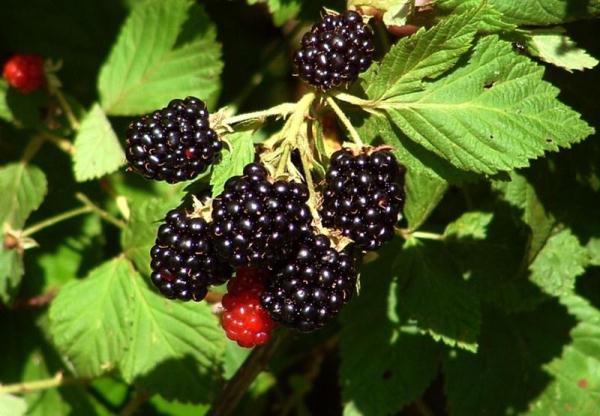In the wild grows amazing blackberry berry. The healing properties are superior to raspberries, but they are not grown on a large scale in Russia.. And on the garden plot blackberry is becoming increasingly popular. Let's consider a detailed description and instructions for the proper care, cultivation, reproduction and pruning of blackberry bushes at home, which will be useful for both experienced and novice gardeners.
Table of contents
The technology of growing blackberries at home in the country
Plantation selection
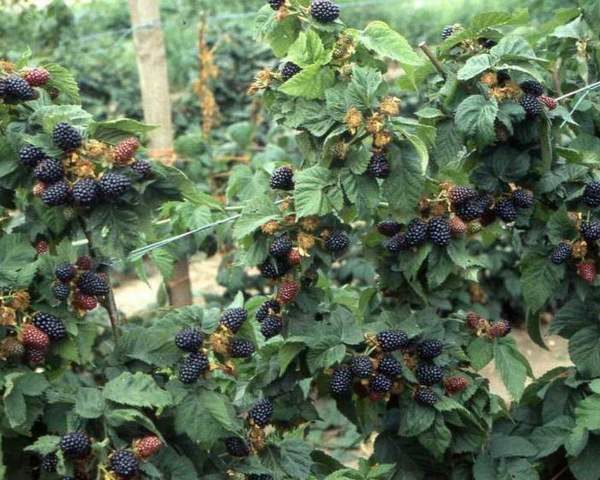
Blackberry reacts to spring frosts and low temperatures. The landing site should be chosen without cold winds.. The best option may be the western and southern part of the house.
The soil
For breeding upright varieties suitable light loam, and heavy loam for climbing species. Feels good plant in sandy soil. Temporary flooding detrimental effect on young shoots. To breed blackberry bushes in the country, it is undesirable to plant a crop on carbonate soils, as the plants will be deficient in iron and magnesium.
Predecessors
We must not forget about the previous culture. Favorable for blackberries on the plot are considered legumes, table beets, carrots, cucumbers, zucchini.
Preparatory work
The plot is prepared for several years for planting, and left fallow.. Cleared of weeds and pathogens. Six months before planting, in the fall to make in the ground organic and mineral fertilizers. If the earth is saturated with nutrients, then organic matter can be excluded.
How to grow blackberries in the garden plot, tips for novice gardeners
Landing in spring
First of all, it is necessary to determine the variety of blackberry, paying attention to the climatic conditions of the place of growth: Moscow region, Siberia or central Russia. Planting material should be selected with a developed root system, which is better to acquire in nurseries. Sapling should have 2 stems and a developed bud near the roots.
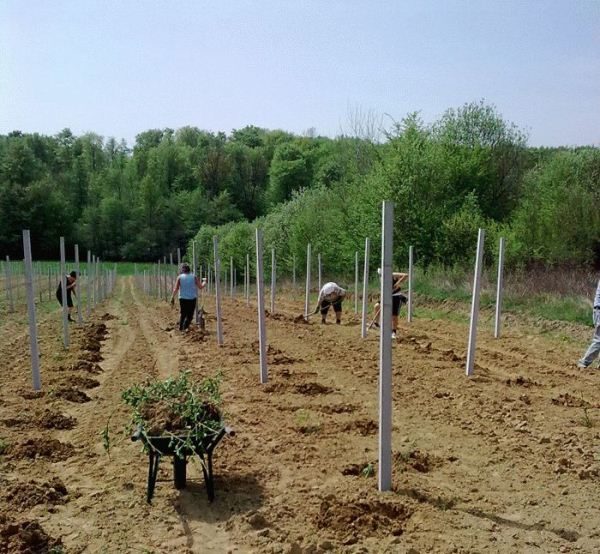
The distance between the planting material to withstand 1 meter, rows - 2 meters. This method is called tape and suitable varieties with a high level of education shoots.
When bush planting The 1.8 x1.8 (m) scheme is used, 2 seedlings are planted in each well and are acceptable for varieties with low formations.
Planting material is lowered into the groove and gently straighten the roots.The soil with fertilizer is poured in from above, the root bud is covered up to 3 cm below the soil. The top layer of the bush is mulched, compacted and watered. Under each bush you need to pour from 3 to 6 liters water. The last step is pruning the seedling up to 20 cm and removing the fruit stem.
Care
Special knowledge for the care of blackberries, to grow a healthy bush is not necessary, it is enough to fulfill the following requirements:
- Watering.
- Weeding
- Top dressing.
- Annual pruning.
- The formation of bushes.
- Destroy pests.
- Timely fight disease.
Methods of breeding blackberries in the Moscow region, Siberia and central Russia
In the garden, blackberries multiply vegetatively (layering, offspring, grafting). This culture can be propagated by the seed method.. It is used to preserve the varietal characteristics of the culture.
Layering
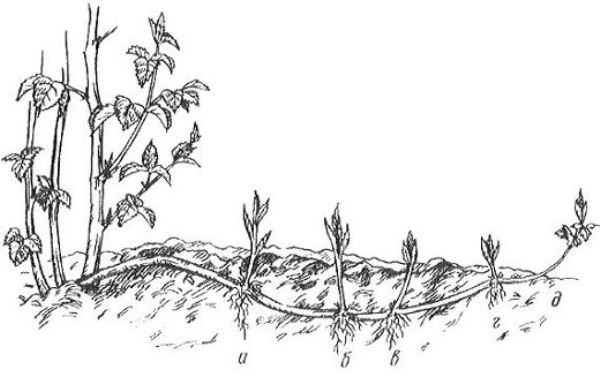
- Prepare the groove, in the first decade of August, with a depth of 15 cm. Put a healthy one-year runaway into it and sprinkle with earth. In this case, the twig is not cut from the uterine bush and leave the crown on the surface.
- The upper part of the shoot trim 10 cm to halt growth.
- Place prikopki press down with a heavy objectFor example, stone, brick or pin the wire.
- Grind the soil and regularly water the place of the digging. Mulch (fallen leaves, sawdust) retains moisture and prevents the growth of weeds.
- Rooting will occur in 2 months. Shoots cut off from uterine bush, gently dug forks, and landed in a permanent place with the earth lump.
- This kind of breeding can be transferred to September or the first decade of October.
Apical shoots
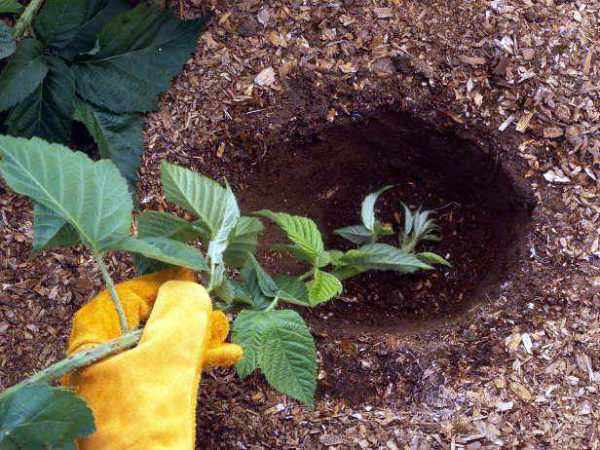
- Tip the tip of the escape and stick it to the ground.. The tip is clipped.
- For quick rooting in the stem that will be in the ground, cut the bark.
- Sapling to separate from the bush and it is necessary to transplant in the spring.
By scraps
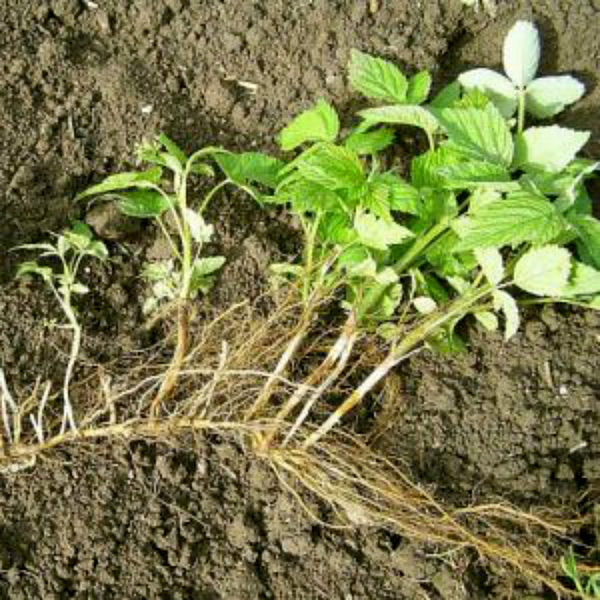
- Young shoots from the root or offspring have bushes 3 years old.
- In the spring, when resistant warm weather is established (May, June), scions are dug out with the roots and a lump of earth. The height of the stem 10-15 cm.
- Planting material is selected from healthy and high-yielding bushes.
- Seedlings planted on picking bed for growing. As soon as the bush reaches the standard size, it is planted in a permanent place.
- Scions can replant in autumn (Aug. Sept). To do this, select the most developed shoots with a thickness of 8-10 cm and a root system of 15-20 cm.
- Before landing cut twig to 30-40 cm.
- Landing to fill a hole with mineral fertilizers.
Hybrids and large blackberries do not give offspring. Therefore, for them, this method of reproduction is unacceptable.
Cuttings
Root
- Early spring or late autumn fruiting shrub digs up by the roots.
- Divided into piecesleaving 60 cm of root system. The cutting should be 0.5–1.5 cm thick, 10 cm long.
- Stem is planted in a permanent place., or on a picking bed, and a year later to use as planting material.
- Beds are prepared and with a spacing between cuttings of 20 cm, rows - 80, planting material is planted and watered regularly, until full rooting.
- Weeding is carried out in the summer from weeds and loosening the soil.
- By autumn, the cuttings will have several shoots and developed root system.
- In winter, cuttings can be stored in a cool place.. The twigs are placed in wet sand. Spring needs transplanting in open ground.
Green cuttings
- In July, a twig is cut off from a green shoot on the third part of it from the top.
- The stalk should consist of a stem., buds and one leaf.
- Process sprig rooting stimulant, for example, root or zirconium.
- Then, make cups of soil (peat and vermiculite in equal parts, expanded clay) and plant cuttings.
- Cover containers plastic bag.
- Root system formed in one month.
- Plant is planted to a permanent place.
- Reproduction can be combined with pruning.
- The most suitable varieties: Black Satin, Thornless Logan.
Seeds
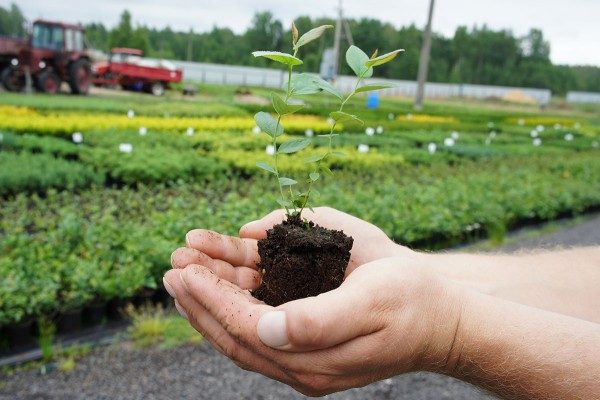
- Prepare a light soil, wet sand or peat crumb.
- Seeds stand 3 hours for swelling in water. Then drain the excess liquid and place in a damp cloth for 3 days.
- Swollen seed grains cover with prepared substrate on 8 mm.
- Soil compacted and water.
- Place containers in a cool place with a temperature 5 degrees C for 2 months.
- During this time monitor soil moisture. It should not be wet or dry.
- Further, to bring containers into a warm room (20 degrees C) for germination.
- The presence of three leaves on shoots serve as a signal for picks.
You may be interested in these publications:
- Detailed description of the blackberry variety Tornfree
- Blackberry variety Black satin - a hybrid of a grade of Darrow with Tornfri
- Description of red currant varieties Sugar
- Proper cultivation blackless bushless
- Winter hardy varieties pears for cultivation in Siberia
Why do we need autumn pruning?
Blackberry bushes bear fruit only once. If the first year is spent on its full-grown cultivation to woody stems, then in the second year of life, it blooms and bears fruit. This is where her fruiting cycle ends. Therefore, from the two-year instances, you should get rid of and properly form a bush. Because:
- young shoots will not receive enough nutrients from the soil, and wasted on old copies;
- young shoots do not ripen, the berries become smaller;
- landing thickening occurs. No access to sunlight in the middle of the bush. From here frost resistance decreases. Complicated harvesting. Berries lose sugar content.
Young specimens should also be cut to stimulate flowering for the next season. Pruning in autumn contributes to the strengthening of the bush, normalizes the load on it, improves aging.
How to trim the blackberry and shape the bush in the fall
Algorithm of actions:
- as soon as the harvest is done, the plantation should be inspected and begin pruning biennial blackberry bushes, to form a strong bush. Hemp must be removed. This will make it possible to avoid purulent processes during hibernation;
- young specimens with thin and short stems are removed, that is, unformed and unripe bushes;
- branches are destroyed, damaged by diseases and pests;
- remaining young stock is shortened to the fourth part. Slice to do higher buds;
- for uniform load on the bush, should leave 6-8 shoots. Given that the plant will overwinter, perhaps, their freezing, we leave two shoots more than 8-10, and in the spring to inspect the plant. To the berries were large and had a good harvest, 5-6 live shoots are needed. Dead branches are deleted..
Formation of upright bush
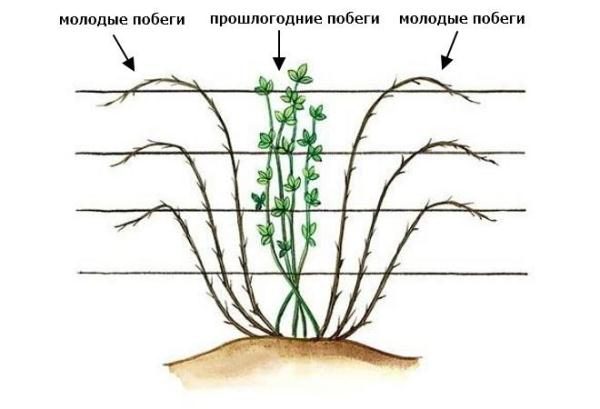
- Prepared trellis, length 1.8 m. with a wire in several rows. The step between them is 30-50 cm.
- Young shoots are attached to the bottom row and evenly distributed from the center of the plant, parallel to the ground.
- Fruiting branches are located in the center.
- In the autumn, after harvesting, the central part is cut to the root, and the young are trimmed and covered for the winter.
The formation of the bush creeping varieties
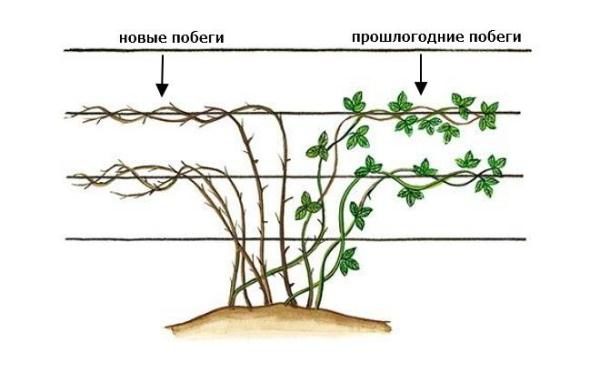
- Creeping varieties have long shoots. The use of trellis allows you to increase the yield, since the branches remain with the maximum length. On the trellis they are fan-shaped in different directions from the fruit-bearing stems on the three lower wires.
- In the spring, the stems are pruned to 1.5 meters.
- During the growing season new shoots appear.They are also tied to the wire horizontally in both directions in the form of a fan. Only next year they will bear fruit. This method facilitates periodic pruning and harvesting.
- It is possible to have branches on a wire in both directions without central fastening. Fruiting stems in one direction, young shoots in another. Each year, picking berries will alternate left and right.
Conclusion
Chosen place and proper care for blackberries: feeding, watering, pruning, processing will allow to get high yields and delight the family with medicinal berries.
